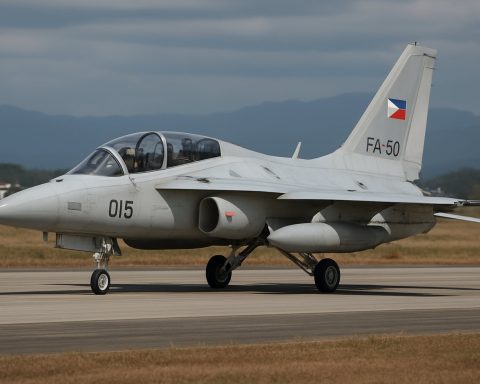- Turkey showcased success in testing its domestically-developed EDPOD, enhancing its advanced defense capabilities.
- The EDPOD equips F-16 fighter jets to effectively detect and navigate enemy radar systems, showcasing Turkey’s technological self-sufficiency.
- Developed by TÜBİTAK, the EDPOD has undergone comprehensive testing, proving its ability to identify and map hostile radar and missile systems.
- This innovation represents a strategic turning point in Turkey’s defense approach, reducing dependency on foreign technology and bolstering national security.
- Industry and Technology Minister Mehmet Fatih Kacir highlighted this milestone as a testament to Turkey’s engineering expertise and resilience.
- The EDPOD is a pivotal element of Turkey’s broader strategy to assert aerospace sovereignty and innovation.
- These advancements reflect Turkey’s commitment to redefining tactical defense and capturing the potential of indigenous technology.
In a display of technological triumph, Turkey unveiled the successful testing of its native marvel, the EDPOD, solidifying its foothold in advanced defense capabilities. This tactical electronic support pod now soars aloft beneath the wings of F-16 fighter jets, echoing a national leap towards technological self-sufficiency.
Visualize an operatic ballet of machinery and intelligence: fighter jets armed with precision instruments designed to invisibly sift through the noise of enemy radar. The EDPOD, crafted by the brilliant minds at TÜBİTAK, has passed rigorous trials, engaging authentically with real-world radar systems in a feat that underscores Turkey’s burgeoning engineering prowess.
Minister of Industry and Technology Mehmet Fatih Kacir shared this milestone on social media, highlighting how Turkey forges ahead in cultivating homegrown critical infrastructures. The exhaustive tests underscore the pod’s capability to not only pinpoint and identify hostile radar systems and missiles but also to geographically map, extract, and archive their intricate parameters with breathtaking accuracy.
This advancement marks a critical stride in Turkey’s broader defense strategy, offering a significant buffer against aerial threats. Imagine a fighter jet, piercing the heavens, equipped with the EDPOD’s eyes and ears, skillfully navigating the electromagnetic fog of warfare. By integrating this indigenous technology, Turkey is determined to transform its defensive posture and assert its sovereignty in aerospace innovation.
The success of the EDPOD demonstrates a critical pivot towards independence in defense technology, reducing reliance on foreign-developed systems and reinforcing national security. As the world watches Turkey’s technological ascent, the EDPOD stands as a testament to the nation’s indomitable spirit of innovation and resilience, poised to redefine the boundaries of tactical defense.
With these compelling advancements, the skies over Turkey shimmer not only with the wings of its aircraft but also with the boundless potential of its technological vision for the future.
Revolutionizing Air Defense: Inside Turkey’s Breakthrough with the EDPOD
Overview of Turkey’s EDPOD Success
Turkey’s recent unveiling of the EDPOD, an advanced electronic support pod, marks a turning point in the nation’s defense capabilities. Designed in collaboration with TÜBİTAK, the EDPOD equips F-16 fighter jets to expertly navigate and conquer the intricate challenges posed by enemy radar systems. This innovation showcases Turkey’s advanced capabilities in developing indigenous technology to bolster national security.
How the EDPOD Works
The EDPOD (Electronic Defense Pod) brings critical capabilities to Turkey’s aerial defense:
1. Radar Detection and Analysis: The main function of the EDPOD is to detect, identify, and analyze enemy radar emissions, making it a critical tool in modern warfare where radar is extensively used for tracking and targeting.
2. Data Mapping and Archiving: The pod can geographically map and store intricate radar parameters, which are essential for tactical planning and electronic warfare operations.
3. Autonomous Functionality: Designed to operate under a wide range of conditions, the EDPOD can autonomously conduct missions without external input, providing a strategic edge in electronic warfare scenarios.
4. Integration with Existing Systems: Compatible with Turkey’s fleet of F-16 fighters, the EDPOD enhances the aircraft’s capabilities without requiring significant modifications.
Real-World Use Cases
– Enhanced Mission Efficiency: By accurately identifying enemy radar, the EDPOD allows jets to maneuver more effectively, avoiding detection and ensuring mission success.
– Strategic Electronic Warfare: The detailed data collected by the EDPOD allows Turkey’s Air Force to plan strategic operations and counter enemy technologies more effectively.
Market and Industry Trends
The development of systems like the EDPOD places Turkey among the leaders in the field of electronic warfare technology.
– Global Defense Spending Increase: Worldwide defense budgets are on the rise, with countries investing heavily in electronic warfare systems to counter sophisticated threats.
– Focus on Indigenous Solutions: Many nations, following Turkey’s example, are looking to decrease dependency on foreign defense technologies, driving self-reliance through indigenous innovations.
Expert Insights & Predictions
Experts in the defense industry agree that the successful integration of the EDPOD signals a future where Turkey could become a leading exporter of advanced military technology, thus bolstering both its economy and geopolitical influence.
Pros and Cons
Pros:
– Reduces dependency on foreign defense technologies.
– Increases tactical flexibility in combat situations.
– Advances national security by ensuring technology sovereignty.
Cons:
– High development and maintenance costs.
– Requires continuous upgrading to stay ahead of evolving threats.
Actionable Recommendations
For nations looking to develop similar technologies:
– Invest in R&D: Prioritize investment in research and development to nurture local talent and innovate new technologies.
– Forge Collaborations: Partner with academic institutions and technology firms to leverage expertise.
– Continuous Training: Ensure personnel are well-trained in the use of emerging technologies to maximize their potential.
Conclusion
Turkey’s EDPOD not only revolutionizes air defense capabilities but also serves as a testament to the nation’s commitment to technological independence. As the EDPOD begins its deployment, it sets a benchmark for other nations to emulate in the pursuit of defense sovereignty and innovation.
For updates on Turkey’s defense innovations, visit the Turkish Ministry of Industry and Technology’s official website: TÜBİTAK.







